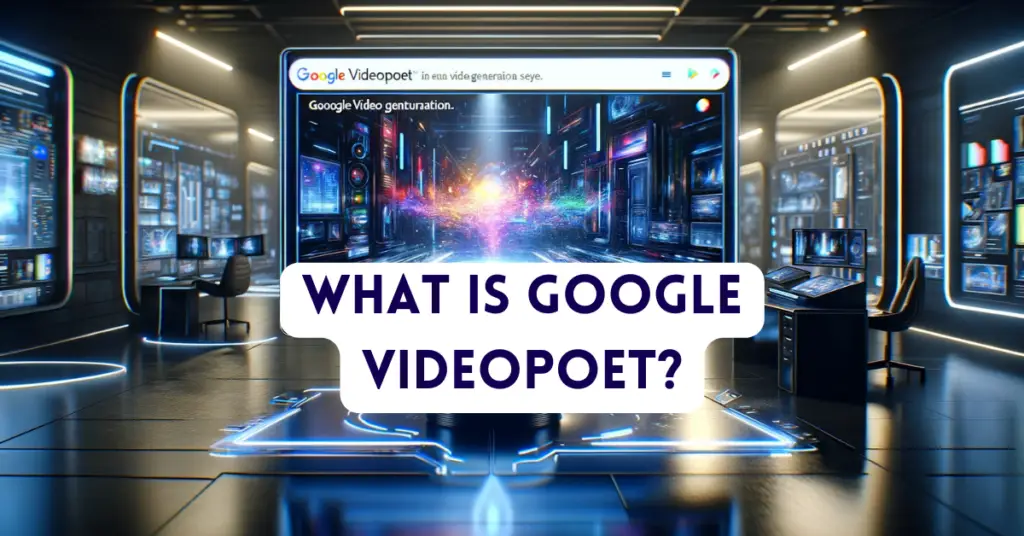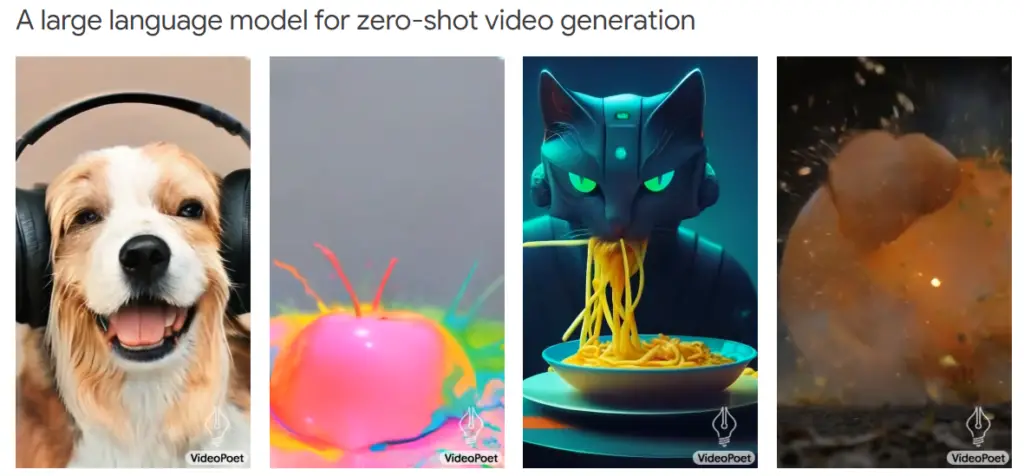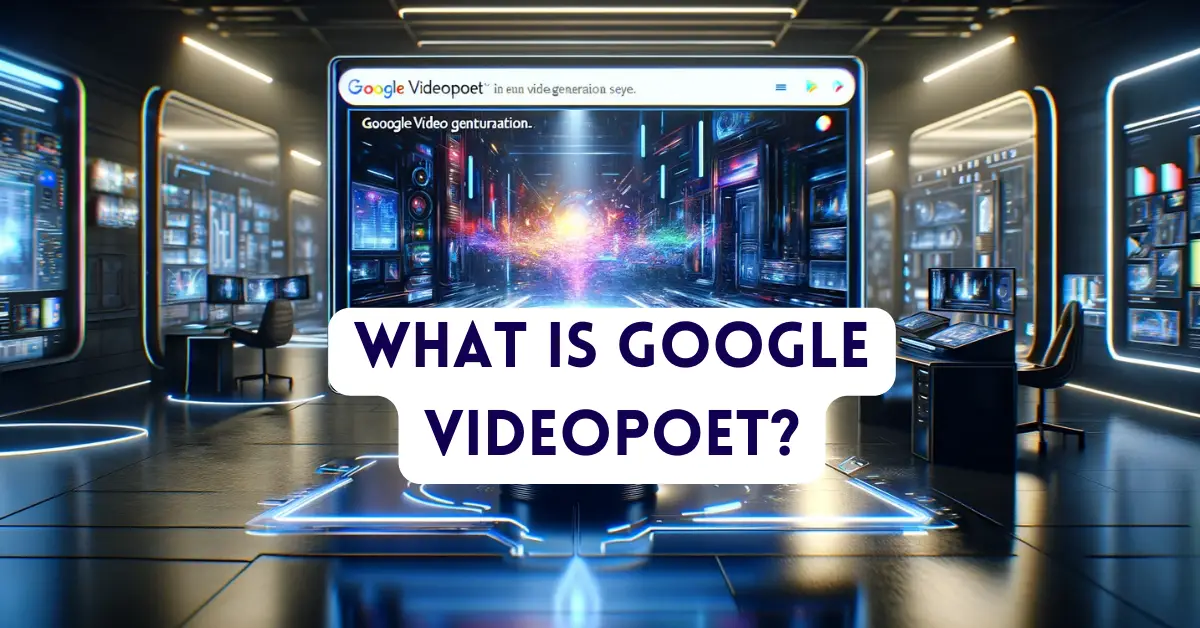Google has made a groundbreaking advancement with the introduction of VideoPoet. This revolutionary tool, developed by the tech giant’s AI division, represents a significant leap forward in the field of video generation. Using the power of large language models (LLMs), VideoPoet is capable of transforming simple text prompts into high-motion, variable-length videos.
Its versatility extends to tasks such as text-to-video, image-to-video, video stylization, and even video-to-audio conversion, setting a new standard in the realm of digital media creation.
This innovative technology not only exemplifies the strides being made in AI but also opens up a plethora of possibilities for content creators, artists, and professionals across various industries.
What is Google VideoPoet?
Google VideoPoet is an innovative video generation model developed by Google. It represents a significant advancement in the field of AI-driven content creation, offering a wide array of capabilities and pushing the boundaries of what’s possible with video generation.

1. Core Capabilities:
VideoPoet excels in creating high-motion, variable-length videos from simple text prompts. It stands out for its ability to generate engaging and accurate videos that match the input text’s fidelity.
The tool is adept at tasks such as text-to-video, image-to-video, and video-to-audio conversions, addressing the challenge of producing coherent large motions without noticeable artifacts.
2. Technical Framework:
VideoPoet employs a decoder-only transformer architecture capable of processing multimodal inputs, including images, videos, text, and audio. This approach integrates various video generation capabilities within a single large language model (LLM), as opposed to using multiple separately trained components.
The use of LLMs offers advantages in learning across different modalities such as language, code, and audio.
3. Training and Operation:
The model is trained using video and audio tokenizers that encode clips as sequences of discrete tokens. These tokens, once generated by the model, can be converted back into viewable representations.
This training technique allows VideoPoet to learn across various modalities including video, image, audio, and text, offering an efficient and versatile platform for video generation.
4. Video Generation:
VideoPoet can animate input images and edit videos for tasks like inpainting, outpainting, and stylization. For video stylization, it predicts optical flow and depth information, which are then fed into the model with additional text input.

This capability allows for a wide range of creative applications, tailoring content to specific stylistic needs.
5. Audio Generation:
Uniquely, VideoPoet also generates audio, enabling the creation of complete audio-visual experiences from a single model.
This feature is particularly notable as it allows for the generation of cohesive video and audio without needing separate processes or inputs for each.
6. Orientation and Content Tailoring:
The model primarily generates videos in portrait orientation, catering to the demand for short-form content. It has been used to create brief movies by stitching together multiple short clips generated from text prompts, demonstrating its adaptability and creative potential.
7. Long Video Generation and Interactive Editing:
VideoPoet can generate longer videos by conditioning on segments of existing footage and predicting subsequent sequences.
It also allows for interactive editing of video clips, including changing the motion of objects within the video, offering significant control over the final output.
8. Motion Control and Camera Movement:
The model can apply motion to images and accurately control camera movements, adding a layer of dynamism and realism to the generated content.
This feature is particularly useful for creating immersive and visually appealing videos.
9. Performance and User Preference:
In evaluations comparing VideoPoet to other models, it consistently ranked higher in terms of text fidelity and motion interestingness.
This user preference data underscores its effectiveness in creating videos that are both accurate to the input prompts and visually engaging.
10. Future Directions:
VideoPoet demonstrates the promising potential of LLMs in video generation. Looking ahead, the framework aims to support “any-to-any” generation, potentially extending to text-to-audio, audio-to-video, and video captioning among other applications.
Google VideoPoet Working:
Google VideoPoet is an advanced video generation model developed by Google AI, designed to produce high-motion, variable-length videos from simple text prompts.
It stands out as a significant advancement in the application of language models to video generation, capable of accomplishing a wide array of tasks such as text-to-video, image-to-video, video stylization, video inpainting and outpainting, and video-to-audio conversion.

The core of VideoPoet lies in its ability to transform any autoregressive language model or large language model (LLM) into a high-quality video generator. This is achieved through a combination of components:
- A pre-trained video tokenizer (MAGVIT V2) and an audio tokenizer (SoundStream) convert images, video, and audio clips of varying lengths into a sequence of discrete codes in a unified vocabulary. These codes are compatible with text-based language models, enabling the integration with other modalities like text.
- An autoregressive language model learns across different modalities including video, image, audio, and text, to predict the next video or audio token in a sequence.
- The model is trained with a mixture of multimodal generative learning objectives, encompassing tasks like text-to-video, text-to-image, image-to-video, video frame continuation, video inpainting and outpainting, video stylization, and video-to-audio. These tasks can be composed together for additional zero-shot capabilities, like text-to-audio generation.
VideoPoet demonstrates a high degree of temporal consistency in synthesizing and editing videos. It has shown state-of-the-art performance in video generation, particularly in creating a wide range of large, interesting, and high-fidelity motions.
The model supports generating videos in square or portrait orientations, catering to short-form content.
Additionally, it can generate audio that matches an input video without requiring any text as guidance, a feature that broadens its applicability in various multimedia applications
How to use Google VideoPoet?
Understanding the current status and usage process of Google VideoPoet is essential for those interested in this cutting-edge video generation technology.
As of the latest information available:
Current Status of Google VideoPoet
- Limited Accessibility: Google VideoPoet is currently not available for public use. The tool is still under development by Google and is being refined and tested within controlled environments.
- Research and Development Phase: VideoPoet is primarily being used within research contexts. Google’s teams are likely using it to explore the capabilities of language models in video generation and to improve upon its existing framework.
- No Direct User Access: General users or developers do not have direct access to the tool. This means that for now, the public cannot use VideoPoet to create or manipulate videos.
How to Stay Informed and Prepare for Future Use
While direct access to Google VideoPoet is not currently possible, there are several steps you can take to stay informed and prepare for its potential future release:
Follow Google Research Updates: Keep an eye on Google’s research blog and official announcements. This is where updates about VideoPoet and other similar technologies are likely to be first shared.
Understand Its Capabilities: Familiarize yourself with the capabilities of VideoPoet by reading existing literature, research papers, and articles about the tool. This will help you understand what it can do and how it might be used in various contexts.
Explore Similar Technologies: Look into other video generation tools and AI models that are currently available. While they might not offer the same functionalities as VideoPoet, they can provide insights into the evolving landscape of video generation technology.
Join AI and Video Tech Communities: Participate in forums or online communities focused on AI and video technology. These platforms often discuss the latest developments and might provide updates on VideoPoet’s availability.
Educate Yourself on Video Generation AI: If you’re interested in using VideoPoet for specific tasks in the future, educating yourself on the basics of AI-driven video generation, including understanding how text-to-video models work, can be beneficial.
Key Features of VideoPoet
1. Wide Range of Movements in Videos:
Videos Full of Action: VideoPoet can create videos that are full of life and action. Whether it’s a short clip or a longer one, the movements in the videos are varied and engaging.
Smooth Transition: It excels in making videos where everything moves in a coherent and appealing manner. The transitions and movements in the videos are seamless, adding to the overall quality.
2. Storytelling Through Video:
Vivid Story Videos: VideoPoet lets you craft stories in video form. As you change your requests, the video evolves, telling a story that captures the viewer’s attention.
Changeable Story Elements: You have the freedom to adjust the story elements in your video. This dynamic change brings your story to life, adding depth to the video narrative.
3. Personalization in Video Editing:
Control Over Video Extensions: This tool gives you the power to elongate and personalize the motion in your videos, offering a high degree of customization.
Tailor-Made Videos: VideoPoet provides options to match your specific vision, ensuring that the final product is aligned with the intended theme or style.
4. Diverse Styles and Visual Effects:
Creative Video Styles: Beyond basic video production, VideoPoet can add unique styles to your videos, all guided by your text instructions.
Customizable Video Effects: It allows for a blend of various styles and effects in your videos. By modifying your text instructions, you can explore a multitude of creative avenues.
5. Customizable Camera Movement:
Flexible Camera Control: VideoPoet introduces an innovative way to control camera movements through text instructions, allowing for specific shot types and angles.
Adaptable Motion Features: The tool’s advanced learning capabilities are evident in its ability to produce customized and high-quality camera motions, enhancing the video’s visual appeal.
Conclusion
In conclusion, Google’s VideoPoet marks a significant milestone in the integration of artificial intelligence with video creation. Its ability to generate high-quality, dynamic videos from mere text prompts represents a paradigm shift in content creation, offering unparalleled ease and flexibility.
This technology has the potential to revolutionize industries, from film and marketing to education and virtual reality, by democratizing access to high-end video production. The implications of such an advancement are vast, potentially leading to more personalized, creative, and accessible media content across various platforms.
Furthermore, VideoPoet’s emergence signifies a broader trend in the AI landscape, where the boundaries between different forms of media are increasingly blurred. By facilitating seamless integration of text, image, audio, and video modalities, this tool not only enhances the creative process but also encourages a more holistic approach to storytelling and communication.
Official Google VideoPoet page is here.
